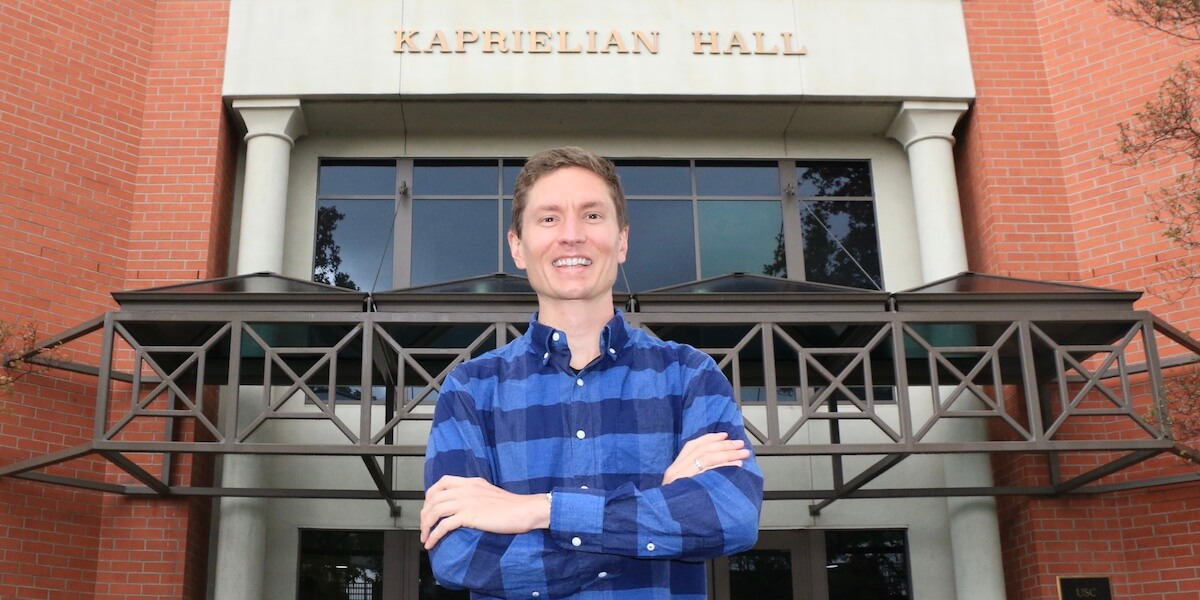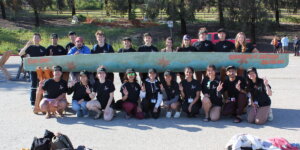
Thomas Petersen pictured outside of Kaprielian Hall
Half of all buildings in the world are made from concrete.
Beloved for its strength, endurance and low costs – concrete has been intrinsically integrated into construction for thousands of years to become the second-most used material in the world after water.
For Thomas Petersen however, his fascination with concrete lies far beyond the surface.
The new assistant professor in the Sonny Astani Department of Civil and Environmental Engineering has built his career on understanding the physics behind the strength, durability and cohesion of cement, a principal ingredient of concrete.
His goal – making the material more sustainable.
“The global production of cement is approximately three times that of steel. The material is here to stay,” said Petersen. “We have to come up with ways that we can both improve our built environment while not doing unnecessary harm to our natural environment.”
While there have been numerous advances in the field of cement sciences over the last two decades, creating cement still significantly contributes to green-house gas emissions.
A report from Norway’s CICERO Center for International Climate Research has found that cement-making accounts for more than 7% of all global CO2 emissions; numbers that have tripled in the last 30 years and doubled in the last 20 years to keep up with its rising demand.
States like California, Colorado, New Jersey and New York recognize that cleaning up the cement industry will be a critical component to achieving climate and health goals; all have passed legislation on cleaner concrete and the trend is only growing.
Carbon dioxide is emitted in two ways throughout the cement-making process, one from the chemical process itself and the other from heating the chemicals.
It’s a problem engineers like Petersen are also working to solve by creating alternative methods and materials.
“There are different approaches that you can take to trying to solve this problem. What drives me is that I’m trying to understand the physics behind cement at a microstructural scale,” Petersen explained.
“How the material organizes itself, and what kind of alternatives you might be able to add to create similar, equal or improved properties. That, in turn, could help make it greener.”
Cement gets its strength and binding properties from calcium silicate hydrate (C-S-H), one of the main contributors of concrete’s high carbon dioxide emission levels. To create C-S-H, limestone is taken out of the ground and heated to around 2800 degrees Fahrenheit. That process strips carbon dioxide out of the limestone, allowing it to enter the atmosphere.
In the pursuit of creating more sustainable cement materials that don’t require carbon dioxide emissions but still contain strong binding properties – Petersen’s research focuses on understanding the mesoscale structure of C-S-H.
“We are producing models that are effective at translating the molecular scale information to the scale at which individual polymers and grains of C-S-H can no longer be discerned, and instead form patterns. These patterns matter because denser structures generally produce a tougher, more resilient material,” said Petersen.
“The physics around cement is still not solved. It’s a complicated material where you must understand physics, you must understand chemistry and you must understand mechanics to use it in some kind of an engineering application. So, it is very much multidisciplinary.”
Petersen is currently in the process of creating a microfluidics lab at USC Viterbi.
The lab is being built to further research how charged particles, including clays and dilute solutions of C-S-H, interact, aggregate, and develop stresses in different electrochemical environments, under differing flow conditions.
A better understanding of this research could possibly lead engineers to find greener alternatives to C-S-H and other materials. Meanwhile, students will receive hands-on experience exploring this unique field of research. Petersen expects to open the lab at the beginning of 2023.
Before joining USC Viterbi in August, Petersen worked at ExxonMobil for three years where he was a senior research engineer. With a master’s degree and Ph.D. from MIT’s Department of Civil and Environmental Engineering, Petersen says he’s eager to get back to research in hopes of engineering solutions that make our planet greener.
Outside of research, Petersen enjoys endurance sports and says you can typically find him hitting the pavement on his bicycle while exploring his new home of Los Angeles. As an avid runner who recently participated in the Boston Marathon in April, Petersen also ran competitively in college.
Beyond the obvious concrete connection between Petersen’s work and his hobbies that place him on miles of concrete for hours at a time — he says there’s also concrete evidence that endurance sports have helped him with his research.
“It lets me step back and look at the bigger picture of what I am trying to do, make sure that I’m not getting too focused on a specific equation or paper that I’m writing. It’s a great outlet for me.”
Published on November 14th, 2022
Last updated on November 14th, 2022










